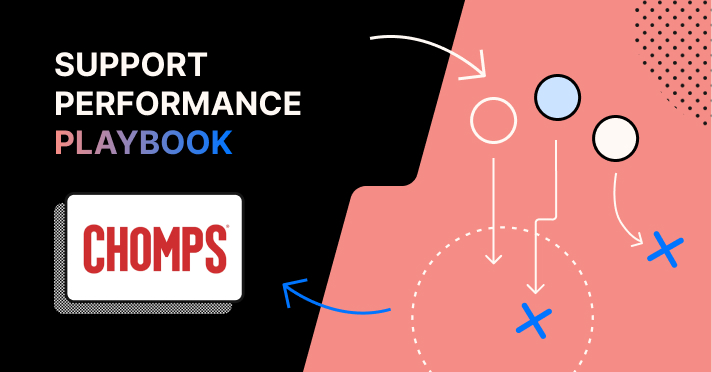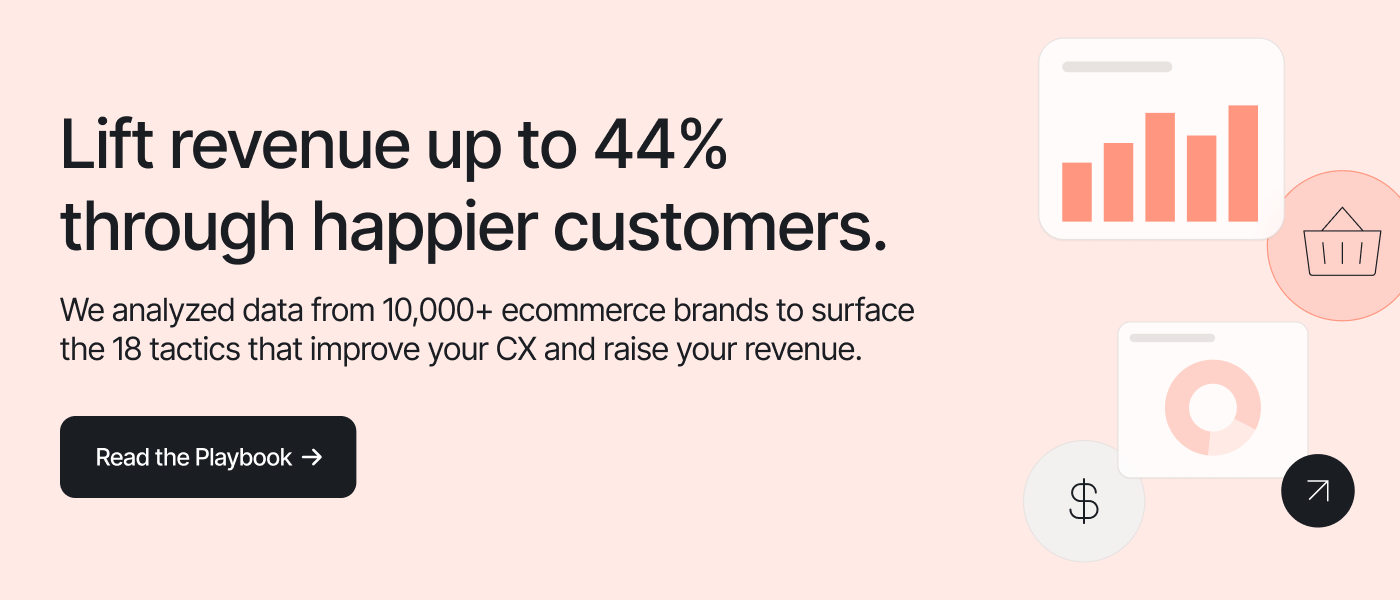There are plenty of reasons your company might use Gorgias. For starters, it keeps your support team organized and efficient (and prevents your laptop from overheating from a million open tabs). But here at Chomps, one of our favorite things about Gorgias is how it helps us analyze tickets to improve our product, customer experience, and brand. Every. Single. Day.
I’m Zoe Kahn, the Sr. Associate of CX here at Chomps. We’re a better-for-you snack brand dedicated to serving the highest quality products and the best experiences to our consumers.

We’ve been using Gorgias for almost a year at Chomps. And at my last company, I switched our helpdesk to Gorgias (where I fell in love with the tool). Big-time Gorgias girlie here.
Below, I’ll show you how we use Gorgias to analyze tickets and surface insights that help us improve the Chomps brand. I hope you can steal some of these ideas to improve your product and brand, too.
What do we learn from ticket analysis?
Ticket analysis means studying customer support conversations to find the root of your customers’ most common frustrations. It’s how you evolve your product to delight customers and build a brand that people genuinely love.
Let’s back up to understand the kinds of insights we can learn. We all know that issues are inevitable, especially in the ecommerce world. Tons of things can go wrong, like:
- Shipping delays
- Lost packages
- Fulfillment errors
- Website crashes
- Inaccurate customer expectations
- The list goes on (and on and on)
{{lead-magnet-1}}
But even when things do go wrong, we want to make experiences seamless for our consumers. At its most basic, this means getting customers answers as fast as possible when they experience issues. But even better, it means being proactive about preventing future issues rather than constantly applying bandaids.
Ticket analysis is how you make all of this happen.
.png)
Every company approaches ticket analysis a little differently. At Chomps, ticket analysis helps us find patterns in support tickets and improve our products and processes. The end goal is more happy customers and a leaner support team — both of which hugely impact the business’s bottom line.
How we set up Gorgias for ongoing ticket analysis
At Chomps, we use multiple tactics for ticket analysis, all based on the tools and dashboards Gorgias supplies. If you’re serious about ticket analysis, you’ll have the most success by first setting up a solid foundation within Gorgias.
Specifically, you’ll want to integrate all of your channels (email, SMS, live chat, and so on) and set up clear Views to keep your work organized.
Once you set your foundation, you’re ready to tag your support tickets. Tagging tickets — consistently and robustly — is the key to analyzing your frequent support issues and making high-impact decisions backed up by data.
At Chomps, we use three methods of tagging to keep track of our ticket trends:
- Auto-tagging based on keywords and support channels
- Manually adding tags to tickets where needed
- Creating macros for top inquiries and monitoring usage
1) Auto-tag based on topics
To get Gorgias to start auto-tagging tickets for you, you’ll set up auto-tags based on your unique business and the kinds of inquiries you usually see. Here are some common tags we use at Chomps that you’ll probably need, too:
- Manufacturer
- Subscription
- Return/Exchange
- Fulfillment
- Order-Status
- Mis-ship
- Wholesale
- Urgent

Let’s use my favorite priority folder as an example: the Urgent tag.
Auto-tagging is super relevant to most DTC businesses: It surfaces tickets that need immediate attention, such as order changes and address updates that need to be implemented before an order’s out the door.
This automation is incredibly useful, especially when you’re dealing with a high volume of tickets.
Here’s what our URGENT tagging rule looks like at Chomps:

Let’s look at the logic:
- The trigger is simple: It runs when tickets get created.
- Next, under “message body CONTAINS ONE OF,” we’re telling the Rule to look for keywords that are good guesses about what urgent tickets might include: things like “cancel” and “update my address.” If a customer uses those keywords, we want that ticket on our radar quickly.
- See the keyword that says “cs_urgent_order_update”? This phrase is always on a ticket if the customer has filled out our contact form (you can build one of these with Gorgias) and selected “Urgent Order Update” as the subject.

We use this tactic across a variety of areas — every single subject in our dropdown list auto-tags the ticket so we can route it correctly.
These tags — whether generated from the form or automatically applied based on keywords — allow us to assign priority and monitor the types of tickets we receive. These tags help us find common issues and inefficiencies and solve issues at the root.
Thanks to this urgent auto-tag Rule, we are more likely to update incorrect customer orders before they’re fulfilled by our warehouse. Since our warehouse team is speedy, if orders aren’t adjusted (almost) immediately, these requests get lost among all the non-urgent requests.
Not being able to prioritize correctly means we either lose money by honoring a replacement order or upset the customer.
The fixes don’t just apply to support operations, either: We’ve made changes to our website, fulfillment processes, marketing emails, and much more based on this kind of bulk ticket analysis.
📚 Related reading: See nine more Rule suggestions for auto-tagging your customer service requests.
2) Manually add tags where needed
We use tags to track ticket types and to understand the percentage of our total tickets that each topic makes up. Automation gets us most of the way there, but even Gorgias’s best-in-class language detection isn’t 100% perfect. Anyone who works in customer service knows that customers can use all kinds of different vocabulary to describe what they’re after.
At Chomps, every team member gets trained to check the tags on a ticket as soon as they start working on it. On top of that, no tickets should ever be closed without applying at least one tag.

Thanks to this vigilance, we have a lot of confidence in the data we’re using for ticket analysis. There’s no point in spending time analyzing support tickets if you think the data is bad, so it’s worth building these habits and processes. Future you will be thankful (and so will all your customers).
💡 Pro tip: If getting your team to check and apply tags is a challenge, you can set up a Rule that reopens untagged tickets or assigns them to a manager.
3) Create Macros for top inquiries and monitor usage
Macros are imperative for keeping an efficient and lean support team. But did you know you can also use macros to monitor inquiries, problems, and customer feedback?
I have a great example of this. At one point last year, we weren’t able to keep up with demand and many of our jerky stick flavors were going out of stock (a good problem to have, but still a problem).
We made efforts to proactively communicate supply issues, like back-in-stock notifications and keeping social media up to date with the available flavors. However, we’d still get an influx of consumers who wanted to know when exactly specific flavors would be back in stock.
Using Gorgias, I was able to set up Macros based on each unique flavor we offer and send these out to every customer who asked. It’s not all that creative, and most support teams and companies would stop there. We didn’t.
.png)
From there, I looked at our team’s Macro usage and reported back to the rest of the company weekly to share which flavors were requested the most. This analysis was crucial because at that time we had to pick and choose which flavors to produce.
We needed clarity on what our consumers really wanted — rolling the dice and gambling on random flavors would have made a bad situation worse. Specifically, we may have ended up with overstock on some flavors, and failed to stock up on flavors customers would actually try to order.

This is just one example. But these kinds of issues are things that pop up all the time when you work in customer service. Getting smart about your Macro creation and monitoring usage unlocks a whole new set of data your CX team can use to understand your customers.
How to implement feedback
You can analyze until you’re blue in the face, but if the outcome isn’t taking tangible action to improve your product, customer support, and brand, does it really matter?
Implementing changes based on your support ticket analysis is where the true brand improvement happens. You can’t do that without creating an impeccable feedback loop with key players across your company.
At Chomps, our CX team has recurring meetings with different parts of the team to share the results of our ongoing ticket analysis. Here are two regular meetings we use to share insights:
Monthly CX & Operations meetings
Each month, we have a meeting between our CX and Ops teams. This is where we go over product complaints, innovation requests, and order fulfillment hiccups.
We like to keep this meeting recurring instead of just doing it when there’s a fire to put out. It allows us to touch base on what’s coming in future months, putting us in a more proactive place. However, we’ll schedule additional meetings if we see an influx in complaints on a certain topic.
We structure the meetings around notable tickets with the following tags, all of which fall into our operations category:
- Manufacturer: These are any complaints about the product that we get about the product, whether it’s about the package being damaged or a customer commenting on the texture. These tickets also get a tag based on which retailer or online shop the customer ordered from. That way, if we see an influx of outreach from a certain retailer, we can dig into it and communicate with the appropriate teams.
- Mis-ship: This is when a customer orders one thing and receives another. while we’d love this never to happen but that’s not possible. We’re happy as long as we can catch it.
- Innovation: This tag is used when customers request a new flavor or snack suggestion. Since the possibilities are endless, we love hearing and sharing these inquiries!
Each month, we analyze the number of tags along with the number of times relevant Macros get used. We compare these to the previous month(s), keeping in mind the percentage of issues compared to sales.
{{lead-magnet-2}}
For example, if the Macro named “Fulfillment - Mis-ship - MISSING” is up 25%, we can reach out to the warehouse team and ask them to look into what might have happened. Maybe there’s a new team member who needs more training or maybe some bins have gotten mixed up. Stuff happens! Issues are inevitable, the trick is to find (and correct) them.
We get a ton of value out of analyzing complaints around things like taste and texture, as well as innovation requests. Our goal is to amplify the voices of our customers to help other teams throughout Chomps understand what matters to our customers, so we can give them what they want.
Weekly CX & Ecommerce team meetings
Each week, we discuss support tickets about sales, user experience, site bugs, and related topics with our Ecommerce team. They take the insights and apply improvements to our site.
For instance, this past summer, we had a “$10 off $49” promotion. Customers experienced confusion about the fact that they had to manually enter coupon codes, and didn’t always understand they needed to reach a $49 threshold for the code to work.
Below is a clipping from an old promo email we sent out for a sale. Customers had to use the code at checkout and ensure the order was over $49. This initially seemed like no big deal to us. But every extra step or stipulation you give the customer is a barrier to conversion.

These are “issues'' we didn’t think of before launching the promotion, but customers wrote in when they experienced these issues. We received emails saying, “I forgot my coupon code,” and noticed conversions decreased. We wondered if it was perhaps because we didn’t provide examples of how to get to the $49 threshold and didn’t offer any “help” at checkout, or examples in the emails.
We were able to improve our promotions in the future thanks to ticket and Macro analysis.
In promotions we’ve held since then, we’ve:
- Implemented an auto-apply discount so customers don’t have to remember codes
- Included clear cart upsell callouts to help customers reach thresholds
- Created clearer graphics for our email, SMS, and social campaigns

We also do a better job of showing the types of discounts customers can receive right on the website, in the flow of shopping:

We also installed a Shopify app that helps guide customers to discounts in their cart — for example, a clear indication of how to unlock free shipping. This helps us increase conversions and average order value (AOV) and decrease customer frustrations and confusion. A win-win for Chomps and our lovely consumers!

Without analyzing these support tickets, we would probably be making the same mistakes over and over again, losing out on sales while frustrating our consumers at the same time.
Take advantage of unlimited seats in Gorgias
This last suggestion isn’t exactly a step in the process. But it’s something to keep in mind as you share customer feedback with your team: Take advantage of the fact that Gorgias allows unlimited seats.
During our new employee onboarding (for all positions at Chomps), we teach new hires how to use the Gorgias platform. They also get to spend a couple days “on the desk,” handling tickets in Gorgias. This is helpful for team onboarding, plus it means we don’t have to hire additional outside help or sacrifice our average response times during peak seasons. We simply grab internal volunteers to help!
This also helps with analyzing issues: Oftentimes, Chomps volunteers from other teams have different insights and can spot issues that we CX folks might not have noticed. For instance, Alexa from our ecommerce team has helped out a few times, and here’s what she told me about using Gorgias:
“As a non-CX'r, Gorgias has made helping out the CX team so much easier. The platform is intuitive. And because our team has built out many Macros, I can easily answer common questions and concerns. Although I'm not on the platform every day, I can toggle between open and closed tickets if I need to reference an old situation and get up to speed quickly and efficiently.”
Ticket analysis (done right) drives great experiences and business growth
Gorgias includes all kinds of tools to help us analyze our support tickets at Chomps. This analysis has tons of impacts:
- We can fix issues, rather than put bandaids on them (or even worse, ignore them!)
- We can scale our brand more efficiently because we’re not constantly barraged by the same tickets over and over
- Our CX team can spend more time on meaningful conversations with our customers
At Chomps, we love to connect with and build relationships with our consumers. We think it’s part of what makes for an exceptional brand. It’s how you get loyal customers. But you can’t do this when your CX team is bogged down with tickets or your product is rife with issues.
Ticket analysis is the secret sauce that uncovers issues so you can focus on delivering exceptional experiences, over and over and over.
Want to keep learning from other Gorgias power users? Check out our recent webinar with jewelry brand Jaxxon. They share how they prepare for peak season and set up customer experiences that drives sales instead of repetitive tickets.


















